Attached files
| file | filename |
|---|---|
| 8-K - FORM 8-K - ARCH RESOURCES, INC. | c60231e8vk.htm |
Exhibit 99.1
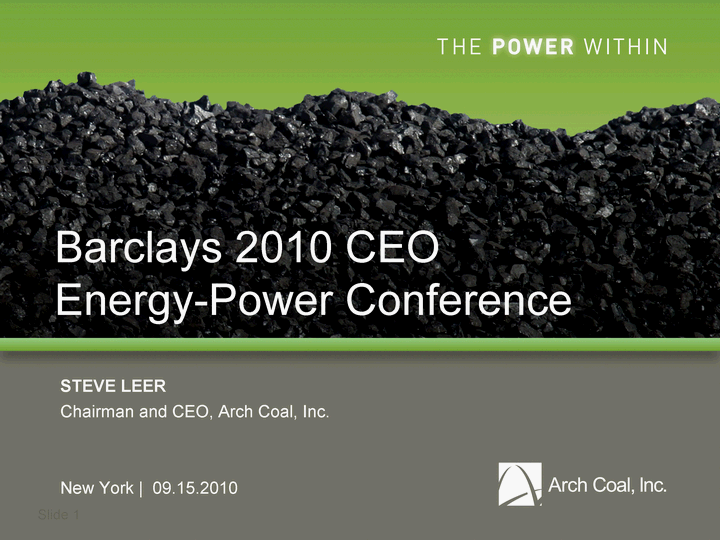
| Barclays 2010 CEO Energy-Power Conference STEVE LEER Chairman and CEO, Arch Coal, Inc. New York | 09.15.2010 |
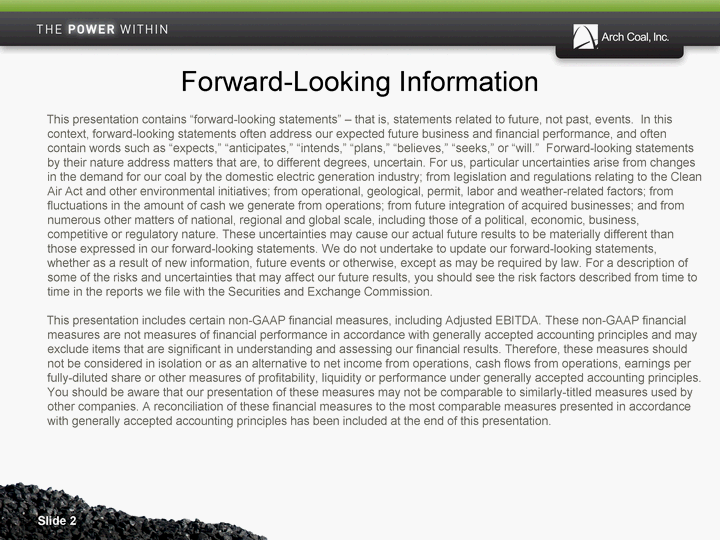
| This presentation contains "forward-looking statements" - that is, statements related to future, not past, events. In this context, forward-looking statements often address our expected future business and financial performance, and often contain words such as "expects," "anticipates," "intends," "plans," "believes," "seeks," or "will." Forward-looking statements by their nature address matters that are, to different degrees, uncertain. For us, particular uncertainties arise from changes in the demand for our coal by the domestic electric generation industry; from legislation and regulations relating to the Clean Air Act and other environmental initiatives; from operational, geological, permit, labor and weather-related factors; from fluctuations in the amount of cash we generate from operations; from future integration of acquired businesses; and from numerous other matters of national, regional and global scale, including those of a political, economic, business, competitive or regulatory nature. These uncertainties may cause our actual future results to be materially different than those expressed in our forward-looking statements. We do not undertake to update our forward-looking statements, whether as a result of new information, future events or otherwise, except as may be required by law. For a description of some of the risks and uncertainties that may affect our future results, you should see the risk factors described from time to time in the reports we file with the Securities and Exchange Commission. This presentation includes certain non-GAAP financial measures, including Adjusted EBITDA. These non-GAAP financial measures are not measures of financial performance in accordance with generally accepted accounting principles and may exclude items that are significant in understanding and assessing our financial results. Therefore, these measures should not be considered in isolation or as an alternative to net income from operations, cash flows from operations, earnings per fully-diluted share or other measures of profitability, liquidity or performance under generally accepted accounting principles. You should be aware that our presentation of these measures may not be comparable to similarly-titled measures used by other companies. A reconciliation of these financial measures to the most comparable measures presented in accordance with generally accepted accounting principles has been included at the end of this presentation. Forward-Looking Information |
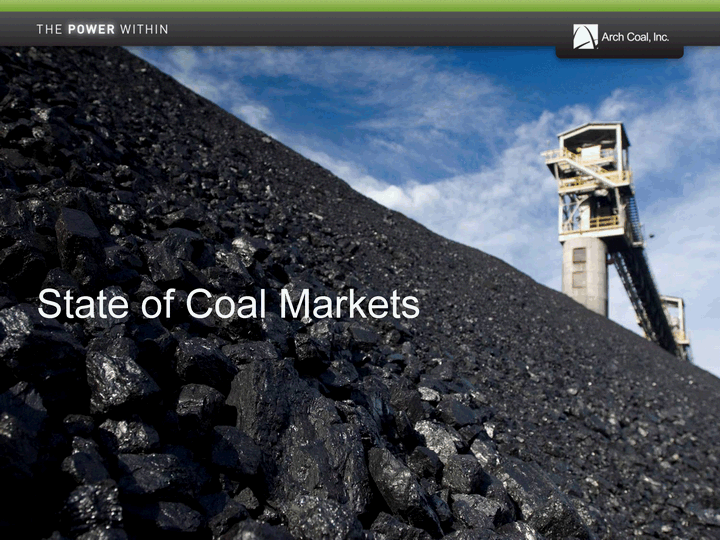
| State of Coal Markets |
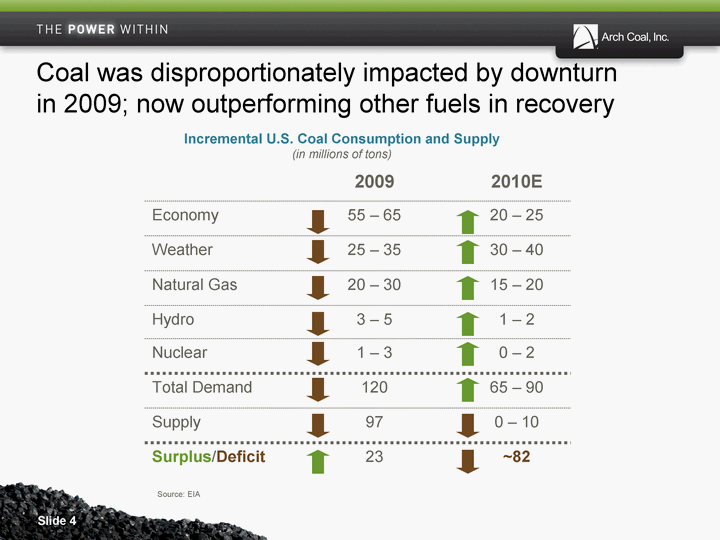
| Coal was disproportionately impacted by downturn in 2009; now outperforming other fuels in recovery Incremental U.S. Coal Consumption and Supply (in millions of tons) 2009 2010E Economy 55 - 65 20 - 25 Weather 25 - 35 30 - 40 Natural Gas 20 - 30 15 - 20 Hydro 3 - 5 1 - 2 Nuclear 1 - 3 0 - 2 Total Demand 120 65 - 90 Supply 97 0 - 10 Surplus/Deficit 23 ~82 Source: EIA |
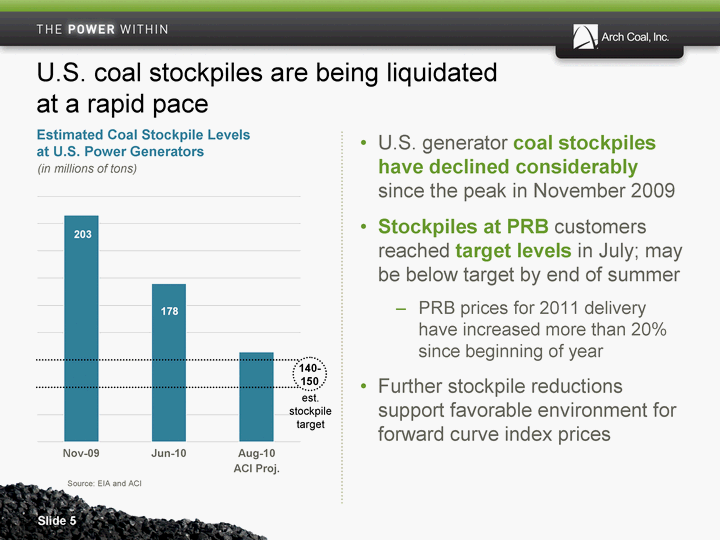
| Slide 5 Nov. 09 6/1/2010 8/1/2010 stockpiles 203 178 153 Estimated Coal Stockpile Levels at U.S. Power Generators (in millions of tons) est. stockpile target U.S. coal stockpiles are being liquidated at a rapid pace U.S. generator coal stockpiles have declined considerably since the peak in November 2009 Stockpiles at PRB customers reached target levels in July; may be below target by end of summer PRB prices for 2011 delivery have increased more than 20% since beginning of year Further stockpile reductions support favorable environment for forward curve index prices 140- 150 Aug-10 ACI Proj. Jun-10 Nov-09 Source: EIA and ACI |
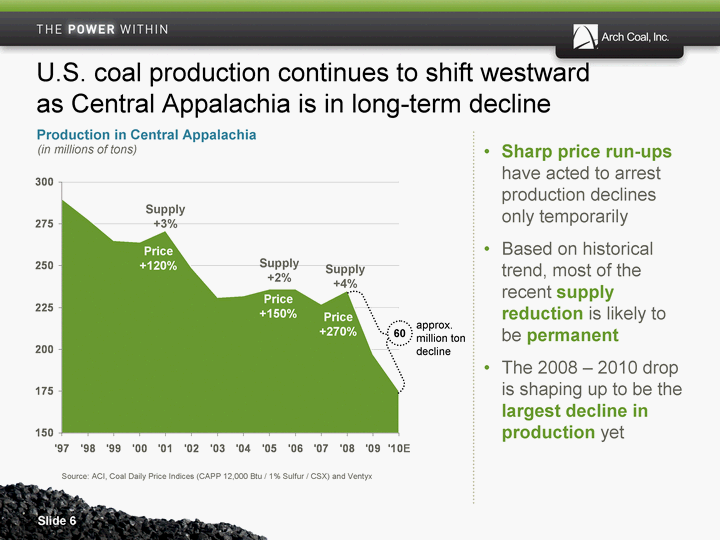
| Slide 6 '97 '98 '99 '00 '01 '02 '03 '04 '05 '06 '07 '08 '09 '10E OECD 290 278 265 264 271 249 231 232 236 236 227 235 197 175 U.S. coal production continues to shift westward as Central Appalachia is in long-term decline Sharp price run-ups have acted to arrest production declines only temporarily Based on historical trend, most of the recent supply reduction is likely to be permanent The 2008 - 2010 drop is shaping up to be the largest decline in production yet Supply +3% Supply +2% Price +150% Price +120% Price +270% Supply +4% approx. million ton decline 60 Production in Central Appalachia (in millions of tons) Source: ACI, Coal Daily Price Indices (CAPP 12,000 Btu / 1% Sulfur / CSX) and Ventyx |
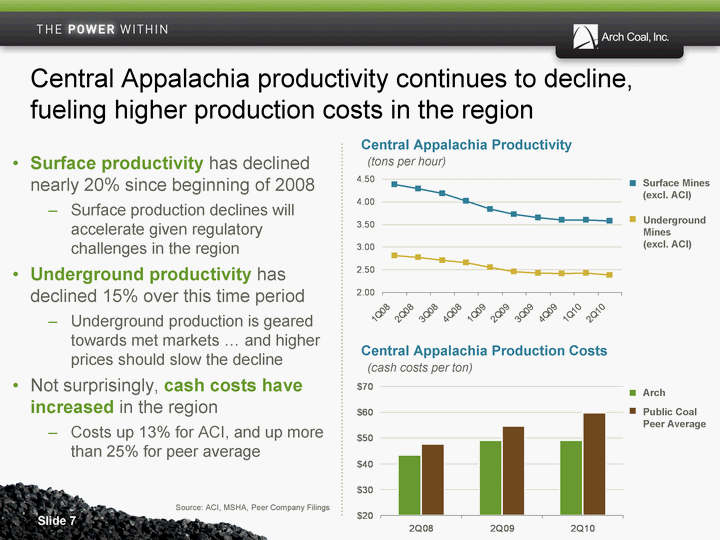
| Underground Mines (excl. ACI) Surface Mines (excl. ACI) 1Q08 2Q08 3Q08 4Q08 1Q09 2Q09 3Q09 4Q09 1Q10 2Q10 Surface 4.39 4.29 4.19 4.02 3.84 3.73 3.65 3.6 3.6 3.58 Underground 2.82 2.77 2.71 2.66 2.55 2.46 2.43 2.42 2.43 2.39 Slide 7 Central Appalachia productivity continues to decline, fueling higher production costs in the region Surface productivity has declined nearly 20% since beginning of 2008 Surface production declines will accelerate given regulatory challenges in the region Underground productivity has declined 15% over this time period Underground production is geared towards met markets ... and higher prices should slow the decline Not surprisingly, cash costs have increased in the region Costs up 13% for ACI, and up more than 25% for peer average (tons per hour) Central Appalachia Productivity 1Q08 2Q08 3Q08 4Q08 1Q09 2Q09 3Q09 4Q09 1Q10 2Q10 ACI 4.39 43.43 4.19 4.02 3.84 49.26 3.65 3.6 3.6 49.19 Public Coal Peer Average 2.82 47.7 2.71 2.66 2.55 54.63 2.43 2.42 2.43 59.87 (cash costs per ton) Central Appalachia Production Costs Arch Public Coal Peer Average Source: ACI, MSHA, Peer Company Filings |
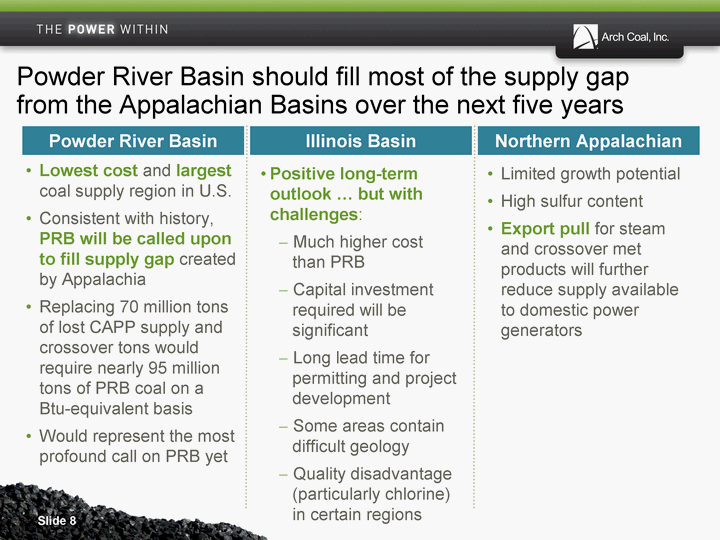
| Powder River Basin Illinois Basin Northern Appalachian Lowest cost and largest coal supply region in U.S. Consistent with history, PRB will be called upon to fill supply gap created by Appalachia Replacing 70 million tons of lost CAPP supply and crossover tons would require nearly 95 million tons of PRB coal on a Btu-equivalent basis Would represent the most profound call on PRB yet Positive long-term outlook ... but with challenges: Much higher cost than PRB Capital investment required will be significant Long lead time for permitting and project development Some areas contain difficult geology Quality disadvantage (particularly chlorine) in certain regions Limited growth potential High sulfur content Export pull for steam and crossover met products will further reduce supply available to domestic power generators Powder River Basin should fill most of the supply gap from the Appalachian Basins over the next five years |
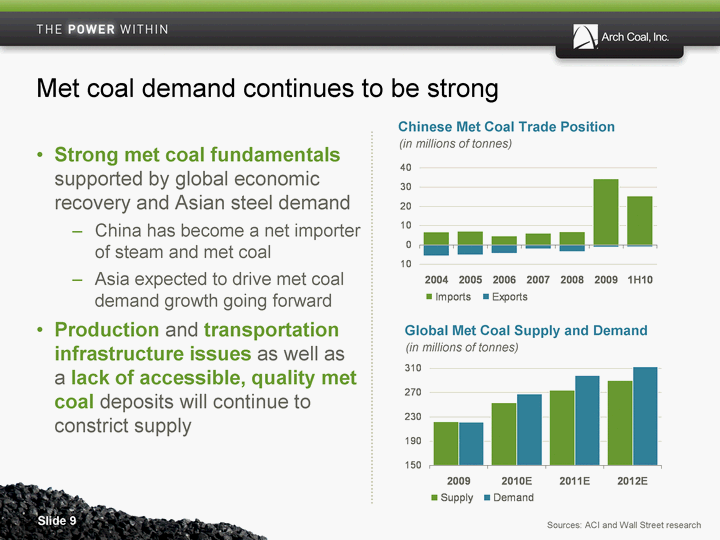
| Slide 9 2004 2005 2006 2007 2008 2009 1H10 Imports 6.8 7.2 4.7 6.2 6.9 34.5 25.5 Exports -5.8 -5.3 -4.4 -2.2 -3.5 -1.3 -1 Met coal demand continues to be strong Strong met coal fundamentals supported by global economic recovery and Asian steel demand China has become a net importer of steam and met coal Asia expected to drive met coal demand growth going forward Production and transportation infrastructure issues as well as a lack of accessible, quality met coal deposits will continue to constrict supply Chinese Met Coal Trade Position (in millions of tonnes) Global Met Coal Supply and Demand (in millions of tonnes) Sources: ACI and Wall Street research 2009 2010E 2011E 2012E Supply 222 253 274 290 Demand 221 268 298 313 |
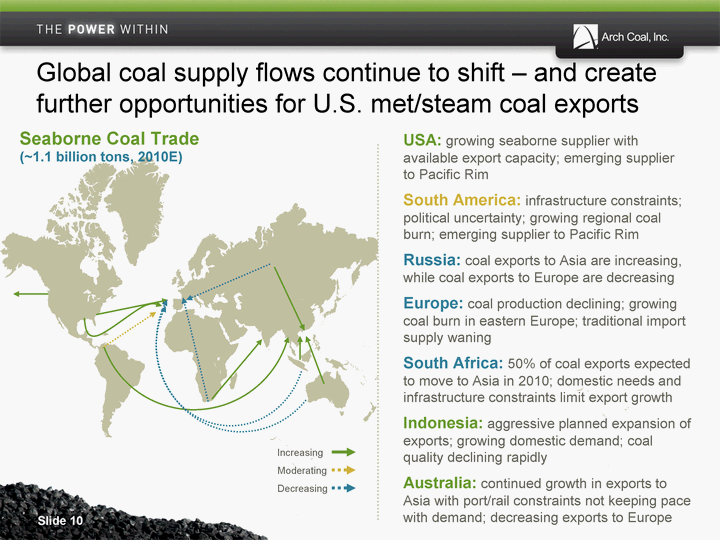
| Slide 10 Global coal supply flows continue to shift - and create further opportunities for U.S. met/steam coal exports USA: growing seaborne supplier with available export capacity; emerging supplier to Pacific Rim South America: infrastructure constraints; political uncertainty; growing regional coal burn; emerging supplier to Pacific Rim Russia: coal exports to Asia are increasing, while coal exports to Europe are decreasing Europe: coal production declining; growing coal burn in eastern Europe; traditional import supply waning South Africa: 50% of coal exports expected to move to Asia in 2010; domestic needs and infrastructure constraints limit export growth Indonesia: aggressive planned expansion of exports; growing domestic demand; coal quality declining rapidly Australia: continued growth in exports to Asia with port/rail constraints not keeping pace with demand; decreasing exports to Europe Increasing Decreasing Moderating Seaborne Coal Trade (~1.1 billion tons, 2010E) |

| Arch Coal Overview |
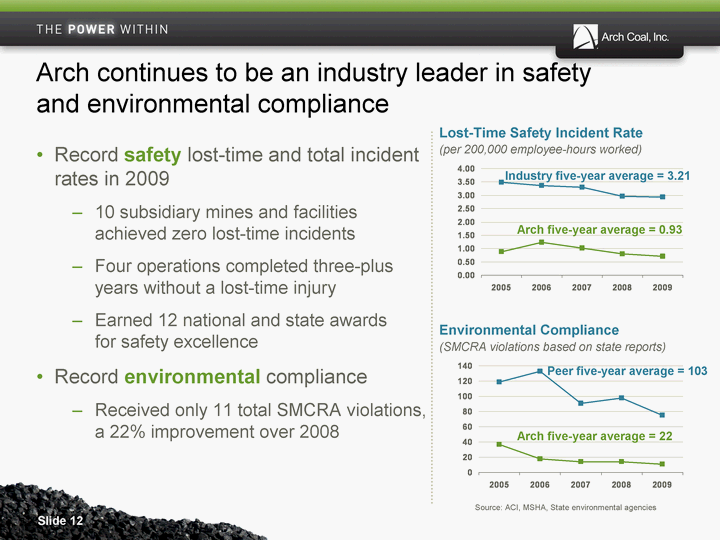
| Arch continues to be an industry leader in safety and environmental compliance Record safety lost-time and total incident rates in 2009 10 subsidiary mines and facilities achieved zero lost-time incidents Four operations completed three-plus years without a lost-time injury Earned 12 national and state awards for safety excellence Record environmental compliance Received only 11 total SMCRA violations, a 22% improvement over 2008 2005 2006 2007 2008 2009 1Q10 Industry 3.49 3.37 3.31 2.97 2.93 3 Arch Coal 0.88 1.23 1.02 0.81 0.71 0.34 Lost-Time Safety Incident Rate (per 200,000 employee-hours worked) Arch five-year average = 0.93 Industry five-year average = 3.21 2005 2006 2007 2008 2009 Peers 119 133 91 98 75 Arch Coal 37 18 14 14 11 Environmental Compliance (SMCRA violations based on state reports) Arch five-year average = 22 Peer five-year average = 103 Source: ACI, MSHA, State environmental agencies |
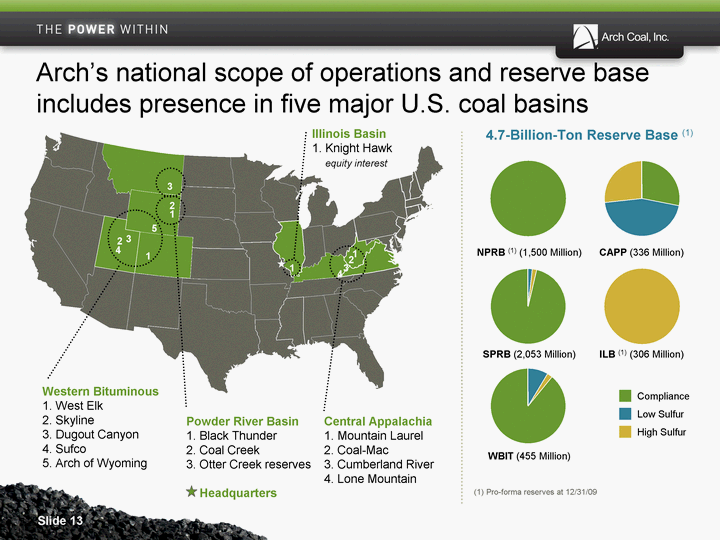
| 1st Qtr 2nd Qtr 3rd Qtr East 0.02 0.02 0.96 1st Qtr 2nd Qtr 3rd Qtr East 0.09 0.02 0.89 1st Qtr East 20.4 Arch's national scope of operations and reserve base includes presence in five major U.S. coal basins 1st Qtr 2nd Qtr 3rd Qtr East 0.28 0.45 0.27 1st Qtr East 20.4 Western Bituminous 1. West Elk 2. Skyline 3. Dugout Canyon 4. Sufco 5. Arch of Wyoming Powder River Basin 1. Black Thunder 2. Coal Creek 3. Otter Creek reserves Headquarters Illinois Basin 1. Knight Hawk equity interest Central Appalachia 1. Mountain Laurel 2. Coal-Mac 3. Cumberland River 4. Lone Mountain 4.7-Billion-Ton Reserve Base (1) (1) Pro-forma reserves at 12/31/09 CAPP (336 Million) NPRB (1) (1,500 Million) ILB (1) (306 Million) SPRB (2,053 Million) WBIT (455 Million) Compliance Low Sulfur High Sulfur 1 2 5 2 3 4 1 4 3 1 2 3 1 |
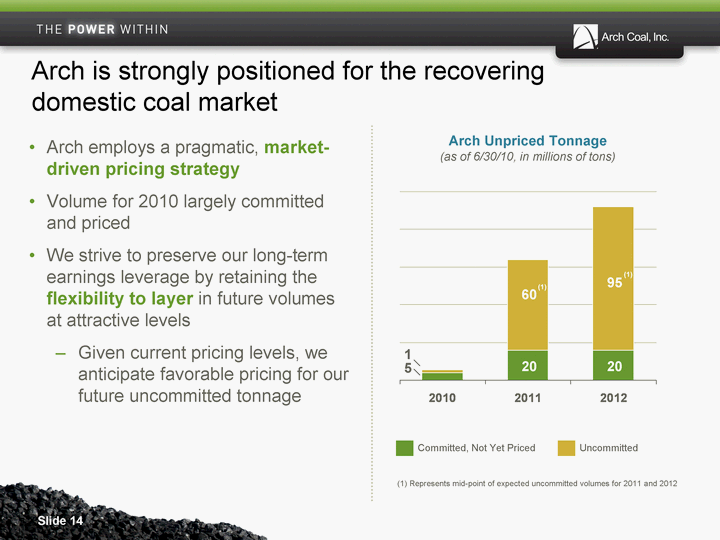
| Arch Unpriced Tonnage (as of 6/30/10, in millions of tons) 2010 2011 2012 Committed and Priced Committed, Not Yet Priced 5 20 20 Uncommitted 2 60 95 Arch employs a pragmatic, market- driven pricing strategy Volume for 2010 largely committed and priced We strive to preserve our long-term earnings leverage by retaining the flexibility to layer in future volumes at attractive levels Given current pricing levels, we anticipate favorable pricing for our future uncommitted tonnage 60 20 95 Committed, Not Yet Priced Uncommitted Arch is strongly positioned for the recovering domestic coal market 20 5 1 (1) (1) (1) Represents mid-point of expected uncommitted volumes for 2011 and 2012 |
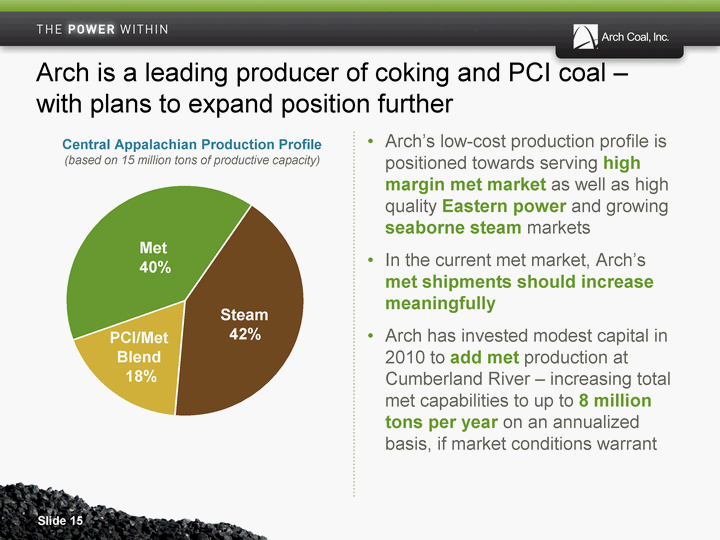
| Arch is a leading producer of coking and PCI coal - with plans to expand position further PCI/Met Blend Met Steam 0.18 0.4 0.42 Central Appalachian Production Profile (based on 15 million tons of productive capacity) Met 40% PCI/Met Blend 18% Steam 42% Arch's low-cost production profile is positioned towards serving high margin met market as well as high quality Eastern power and growing seaborne steam markets In the current met market, Arch's met shipments should increase meaningfully Arch has invested modest capital in 2010 to add met production at Cumberland River - increasing total met capabilities to up to 8 million tons per year on an annualized basis, if market conditions warrant |

| 2009 2010 2011 2012 2013 2014 2015 2016 2020 Debt 44 67.76 110.9 0 65 0 0 0 Notes 3 454.098 586.265 500 Pro Forma Debt Maturity Profile (1) (at 6/30/10, in $ millions) Arch maintains one of the strongest and cleanest balance sheets in the U.S. coal industry Peer 1 Peer 2 Competitor #3 Peer 3 Peer 4 ACI pension 192 215 96 56 69 reclamation 533 452 116 206 235 310.4 postretirement medical 2844 982 487.9 710 162 46 workers comp 375 9 35 44 115 37 CNX BTU Peer 3 ANR MEE Legacy Liabilities of Largest U.S. Coal Companies (at 12/31/09, in $ millions) $3,944 $1,056 $1,658 $567 $462 Peer 1 Peer 2 Peer 3 Peer 4 ACI $111 $586 Financing initiatives in 2009 enhanced liquidity and extended debt maturities Recent transaction reduced 2013 maturity tower Available liquidity is more than $850 million (2) Low level of legacy liabilities versus largest U.S. coal companies Two-thirds of Arch's legacy liabilities are comprised of reclamation liabilities $68 Revolver/other short-term debt Existing Senior Notes Workers' Comp Post-Retirement Medical Reclamation Pension $65 $454 $0 $0 $0 $500 New Senior Notes Source: ACI and SEC filings (1) Values for existing senior notes represent book values net of unamortized discount; value for new senior notes represents face value (2) Represents unused available borrowing capacity under ACI's revolving credit facility, accounts receivable securitization program and commercial paper placement program |
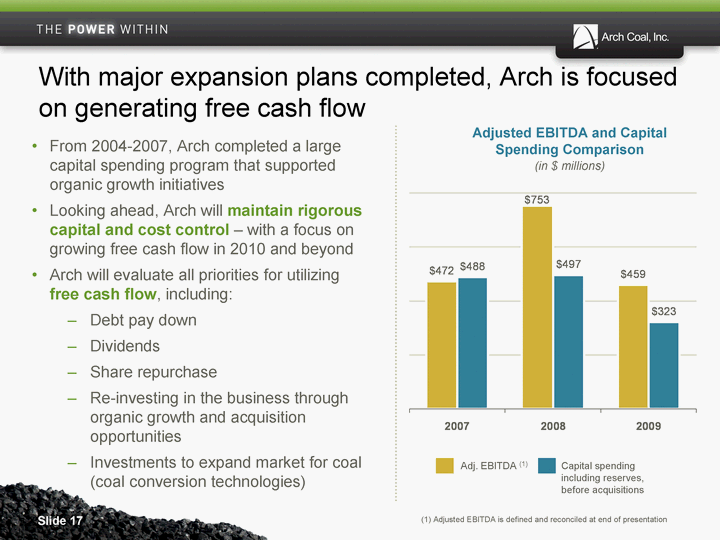
| With major expansion plans completed, Arch is focused on generating free cash flow Adjusted EBITDA and Capital Spending Comparison (in $ millions) 2005 2006 2007 2008 2009 Adj. EBITDA 290.6 545 471.7 753.2 458.7 Capital Expenditures 9 623.187 488.4 497.3 323.2 Uncommitted 0 6.5 75 105 Adj. EBITDA (1) Capital spending including reserves, before acquisitions (1) Adjusted EBITDA is defined and reconciled at end of presentation From 2004-2007, Arch completed a large capital spending program that supported organic growth initiatives Looking ahead, Arch will maintain rigorous capital and cost control - with a focus on growing free cash flow in 2010 and beyond Arch will evaluate all priorities for utilizing free cash flow, including: Debt pay down Dividends Share repurchase Re-investing in the business through organic growth and acquisition opportunities Investments to expand market for coal (coal conversion technologies) |

| EBITDA Reconciliation Chart Included in the accompanying presentation, we have presented certain non-GAAP measures as defined by Regulation G. The following reconciles these items to net income as reported under GAAP. |
